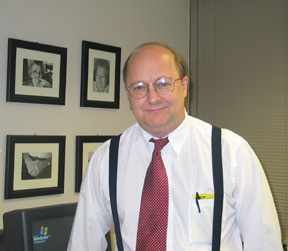 Ed Vandenberg, M.D., is on a mission to improve end-of-life care in Nebraska.
Ed Vandenberg, M.D., is on a mission to improve end-of-life care in Nebraska.
As president of the Nebraska Medical Directors Association (NMDA), a group of physicians who direct care in nursing homes, Dr. Vandenberg feels he is in a unique position to make a difference.
“It is felt that in our culture, nursing home patients are forgotten,” Dr. Vandenberg said. “Perhaps the dying nursing home patient is most forgotten. Compared to hospitals or hospice care, nursing homes receive the lowest ratings in quality of end-of-life care.”
Goal: Freedom from pain
Dr. Vandenberg said freedom from pain is the number one wish of people when they express their feelings on what would constitute a “good death.”
However, in 2000, 45.3 percent of Nebraska’s nursing home patients reported themselves in “persistent pain.”
Nationally, the areas of concern expressed by family members for dying loved ones were improved control of pain, shortness of breath, fatigue and delirium. Despite these concerns, shortness of breath was not treated in 23 percent of patients, opiods (pain killers) were used in only 27 percent, delirium was untreated in 38 percent, and noisy breathing at death was left untreated in 33 percent.
Hawaii excels in end-of-life pain management
“We’ve come a long ways in nursing home care since the 1970s when we were so neglectful, but we still have a ways to go,” Dr. Vandenberg said. “Nebraska ranks in the middle of the pack in its end-of-life care in nursing homes. We can do so much better.”
He cited Hawaii as the state that is doing the best job of providing end-of-life pain management in nursing homes. “Some of the reasons Hawaii is doing a better job are because its health professionals have a higher level of awareness, knowledge and motivation. That’s what we need to strive for in Nebraska,” Dr. Vandenberg said.
Improving end-of-life care in Nebraska
The NMDA has formed a coalition with two other groups – the Nebraska Health Care Association (NHCA), which represents most nursing homes in the state, and the Nebraska Hospice and Palliative Care Association (NHPCA) – in an effort to improve end-of-life care in Nebraska.
“End-of-life care is a constant, moving target. It’s something that we’re always trying to improve,” Dr. Vandenberg said. “We have to do a better job of providing symptom management and emotional support. Medicine has all the tools to do a better job, and it’s relatively inexpensive.”
Educating health professionals
Educating health professionals on quality end-of-life care is essential to improving care, Dr. Vandenberg said. Next spring, NHCA and NHPCA will hold two meetings in Lincoln, which will provide an ideal setting for health professionals to gain the knowledge and motivation they need to do a better job.
Important issue in aging state
End-of-life care is even more important in Nebraska, which has a higher percentage of its population over the age of 65 than most other states. In Nebraska, there are 242 long-term care facilities with 15,760 residents. The majority (68 percent) of nursing home residents are located in predominantly rural counties.
In Nebraska, more than 35 percent of all elders die in nursing homes, Dr. Vandenberg said, and this number is expected to exceed more than 40 percent by 2020.
Next to the nuclear energy field, nursing homes are the second highest regulated industry in the United States. Yet, much to Dr. Vandenberg’s chagrin, the federal government “has not pushed end-of-life care.”
Surveying families
Dr. Vandenberg is medical director for the Thomas Fitzgerald State Veterans Home at 156th and Maple Street in Omaha. The 120-bed facility is solely for military veterans and their spouses who served in armed conflict.
“One way we seek to do a better job is by surveying families every year on how we’re doing,” Dr. Vandenberg said. “This provides valuable information.
“Many residents fear pain and other uncomfortable symptoms of the dying process. It’s always been known that one of people’s biggest fears is dying alone. At the Thomas Fitzgerald Home, we work to control all these symptoms. Dying alone is the most difficult to control as some of our residents don’t have families and wind up dying alone. This just breaks my heart.
“We have many retirees. If these retirees would just give a half-day each week to sit with someone in a nursing home, read to them, watch TV with them, hold their hand, we could meet the demand in a heart beat. Nursing homes would be thrilled.”
Assessing one’s final weeks
Dr. Vandenberg said the final weeks of a person’s life can be especially challenging. “Patients can get extremely agitated and frightened,” he said. “As health professionals, we have to be sleuths and figure out what is happening. Is it pain? Is it fear? Is it loneliness? A lot of these things can be treated with medications.”
Pain is the easiest thing for health professionals to treat, Dr. Vandenberg said. As an example of successful pain management, he cited the example of one of his patients who suffered from metastatic prostate cancer that had spread to his bones.
“He was in tremendous pain, so much so that he couldn’t even converse with his family. We quickly but carefully increased his pain medications, and he was able to meet and converse with his family and make his final days meaningful.”
Dr. Vandenberg fondly remembers his grandmother as someone who had quality end-of-life care. “Grams almost made it to 101,” he said. “She fell down and broke her hip. She had told us before that at her age, it would have made no sense to put her through surgery and try to repair the hip. We made the decision to just keep her comfortable. Within a few days, she died of pneumonia. It was a very comfortable death.”